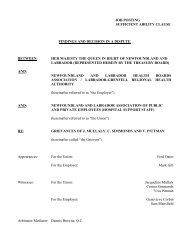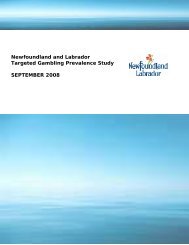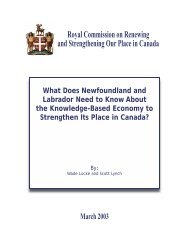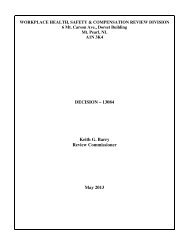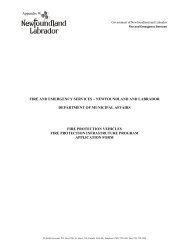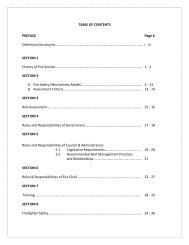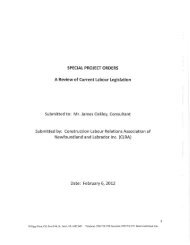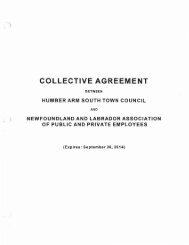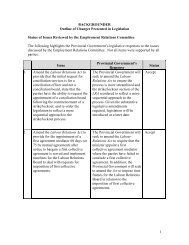Energy Plan - Government of Newfoundland and Labrador
Energy Plan - Government of Newfoundland and Labrador
Energy Plan - Government of Newfoundland and Labrador
You also want an ePaper? Increase the reach of your titles
YUMPU automatically turns print PDFs into web optimized ePapers that Google loves.
Capturing the Value <strong>of</strong> our Renewable<br />
<strong>Energy</strong><br />
As nations around the globe focus on finding ways to transition their economies<br />
to reduce, <strong>and</strong> ultimately eliminate, greenhouse gas emissions, increased<br />
dem<strong>and</strong> for renewable energy sources will increase the value <strong>of</strong> our portfolio <strong>of</strong><br />
renewable hydro <strong>and</strong> wind generation.<br />
In the long term, we will set a goal <strong>of</strong> greatly reduced GHG emissions. While caps<br />
on emission intensity (where caps are set per unit <strong>of</strong> production), <strong>and</strong> ultimately<br />
fixed emission caps will limit GHG emissions, various mechanisms have been<br />
proposed to help emitters make this transition. These include the purchase or<br />
trading <strong>of</strong> another party’s reductions (<strong>of</strong>fset credits) as well as investment in<br />
projects that can definitively reduce emissions through a technology. We must<br />
take actions that are both environmentally progressive <strong>and</strong> economically prudent<br />
as we take the necessary steps to reduce emissions.<br />
Policy actions that either limit the use <strong>of</strong> GHG emitting fuel sources or favour<br />
investments in renewable projects will facilitate the development <strong>of</strong> our renewable<br />
energy resources.<br />
Carbon Offsets <strong>and</strong> Trading<br />
Controlling emissions <strong>of</strong> harmful substances through issuing allowances, also<br />
called permits or credits, which can be traded among regulated companies, is<br />
an increasingly common approach to reducing emissions in many jurisdictions.<br />
Provided the overall number <strong>of</strong> allowances is limited <strong>and</strong> the regulatory regime is<br />
enforced, a tradable emission allowance scheme should result in the reduction<br />
<strong>of</strong> emissions in the most economic manner. We recognize, however, that this<br />
approach must ensure flexibility for each jurisdiction in the country.<br />
Greenhouse gases (GHGs) play a major role in global climate change regardless<br />
<strong>of</strong> where in the world they are emitted. This makes them excellent c<strong>and</strong>idates<br />
for control through tradable allowances. A GHG emission trading scheme for<br />
Canada has been the subject <strong>of</strong> discussion for almost a decade. In April <strong>of</strong> this<br />
year, the Federal <strong>Government</strong> released a Regulatory Framework for Air Emissions.<br />
Under this Framework, several elements <strong>of</strong> which are still in a consultation phase,<br />
firms will be allowed to meet their emission regulatory requirements through<br />
domestic inter-firm trading <strong>of</strong> emission credits <strong>and</strong> the trading <strong>of</strong> <strong>of</strong>fset credits.<br />
Offset credits are provided for emission reductions that take place outside <strong>of</strong><br />
regulated emitting activities. Industrial emitters would also have access to<br />
qualifying credits from the Kyoto Protocol’s Clean Development Mechanism.<br />
54



